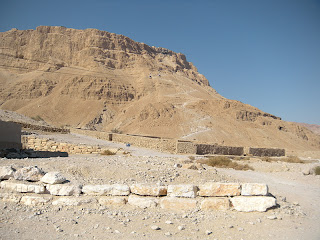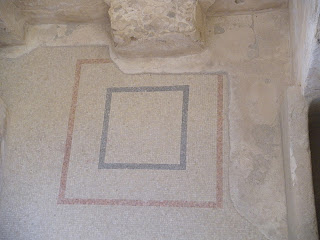*I first want to say praise the Lord. This past week there
has been so much rain. The other day there was even hail coming down. Which
probably is not good for the crops, but it was cool to see hail in the desert.
After Christmas, my old roommate from West Point messaged me
on Facebook. He said that he would be in Israel for 10 days at the beginning of
January. I thought he was joking, but last week I met up with him in Jerusalem.
This is a picture of us at the Western Wall. He is in the middle..
The Jewish National Fund (JNF) was funding a trip for
student leaders to come to Israel. There were three people from West Point and
a handful from all over the Country at different colleges. And when I arrived JNF let me join their tour
of Jerusalem. I was only with them a day in a half, but it was so nice of them
to let me join. I was able to hang out with old friends, make new friends, and
get a free tour of Masada, the Dead Sea, and Qumran.
Qumran is where the Dead Sea Scrolls were found. They contain
the oldest written copies of the Bible we have today. It is very important because the farther we get from the original text the more errors usually happen. For example, the game telephone. Why do we often have 2 books
in the Bible (ie 1 Kings and 2 Kings)? I found out that it often has nothing to do with a
natural breaking point or a “to be continued” cliff hanger. It was the amount
the writer of the scroll that could fit on a piece of parchment. With longer books
like Psalms the writer would sew pieces of parchment together.
I also found out why the Dead Sea scrolls are often found in
pieces and not altogether. It has nothing to do with the fact that they are
old. You see a young Bedouin (nomad) shepherd lost a sheep in these mountains
(when were they found). Well of course he started to get mad and began to throw
stones into the caves hoping to hear a sheep. But instead he heard the sound of
jars breaking. So he went into the cave and found tons of jars with scrolls
inside. He thought that the material would make good sandals. So the first
scroll from the caves where made into sandals by the young boy. (Pretty Crazy!!! This boy had no idea what he
had). So he began to take the scrolls to Bethlehem to sell as sandal material.
A local archaeologist came across this boy and bought the first scroll entirely
intact. He told the boy that if he had more that he would pay more for them.
The young boy went back to his village and told them about the caves. They
began collecting from 11 caves as fast as they could. The Bedoiuns soon
realized that if they cut the scroll into pieces they would get more because
the archeologist paid by the piece. So each scroll was found then cut into
pieces and sold. That is why many of the scrolls are not altogether, but were
pieced together later on. The pictures that follow are of the village
surrounding the caves where the scrolls were written by a sect of Jewish people.
These people wore all white clothing and were all males. They only saw females
during the holidays for “repopulation.” They sat all day copying the Torah and
cleansing themselves in the Mikvas (ritual bath). They most likely hid these
scrolls when they fled from the Romans. They did it hoping one day to come back
and restart their civilization.More info http://www.centuryone.com/25dssfacts.html
 |
| One of the 11 caves |
 |
| A diagram of a Mikva |
 |
| This aqueduct would trap the water from flash floods that often happen in the desert. Then lead the water around the city as t o not flood the people's homes. |
 |
| The water would also be trapped here to provide water for the village. |
 |
| This is where they believe a long table sat on which they wrote the scrolls. |
 |
| This is cave #7 where they found the entire book of Samuel. |
 |
| This is a grave marker as one can see by the circle of rocks. This sect of Judaism would bury their citizens upright and put rocks on top to keep the soul inside the body. |
 |
| I went to Qumran on my hover round |
 |
| The Dead Sea |
The next stop is the ancient and amazing fortress on the top
of a mountain called Masada. I walked aup with a group and it took us 45
minutes which was not too long, but a good distance for those who needed
protection. "
Some 75 years after Herod’s death, at the beginning of the Revolt of the Jews against the Romans in 66 CE, a group of Jewish rebels overcame the Roman garrison of Masada. After the fall of Jerusalem and the destruction of the Temple (70 CE) they were joined by zealots and their families who had fled from Jerusalem. With Masada as their base, they raided and harassed the Romans for two years. Then, in 73 CE, the Roman governor Flavius Silva marched against Masada with the Tenth Legion, auxiliary units and thousands of Jewish prisoners-of-war. The Romans established camps at the base of Masada, laid siege to it and built a circumvallation wall. They then constructed a rampart of thousands of tons of stones and beaten earth against the western approaches of the fortress and, in the spring of the year 74 CE, moved a battering ram up the ramp and breached the wall of the fortress.
Josephus Flavius dramatically recounts the story told him by two surviving women. The defenders – almost one thousand men, women and children – led by Eleazar ben Ya’ir, decided to burn the fortress and end their own lives, rather than be taken alive. “And so met (the Romans) with the multitude of the slain, but could take no pleasure in the fact, though it were done to their enemies. Nor could they do other than wonder at the courage of their resolution, and at the immovable contempt of death which so great a number of them had shown, when they went through with such an action as that was.”
The Zealots cast lots to choose 10 men to kill the remainder. They then chose among themselves the one man who would kill the survivors. That last Jew then killed himself.
The heroic story of Masada and its dramatic end attracted many explorers to the Judean desert in attempts to locate the remains of the fortress. The site was identified in 1842, but intensive excavations took place only in 1963-65, with the help of hundreds of enthusiastic volunteers from Israel and from many foreign countries, eager to participate in this exciting archeological venture. To them and to Israelis, Masada symbolizes the determination of the Jewish people to be free in its own land." We went over this story and I found in on http://www.jewishvirtuallibrary.org/jsource/Archaeology/Masada1.html. This website also has more info. The pictures follow.
 |
| Masada is at the top of this mountain . |
 |
| From the top! The little square to the right was a roman fortress. |
 |
| Diagram of Masada |
 |
| The black line represents what they found in tact. Everything above the black line is built to give the visitor more of a visual. |
 |
| A diagram of one of King Herod's guest houses. |
 |
| The mosaic on the guest house floor. |
 |
| The group. |
 |
| Another Roman fortress. |
 |
| Where the water would have been stored. |
 |
| Roman fortress |
So we went to the Dead Sea after Masada and there are no
pictures. In fact, my camera broke at Masada. Something to do with a “lens
error” and I am working on fixing this. Because if I don’t their might not be
any more pictures. This would be bad. But despite the fact that I do not have
any pictures the Dead Sea was amazing even the second time around. And my skin
feels so smooth. There was even people doing Mikvas in the Dead Sea, which is
not advised because in a Mikva one must fully submerge the head. Salt in the
eyes, ears, and nose. No thank you!
It was great to see my old roommate and it really reminded
me why I was here. It reminded me that West Point is still the same and I am
not missing out on anything. Also that I need to take advantage of this time when I
have no distractions from the Lord.
Oh I have also started to take Nissim and his farm into the
21st century. I am currently going through 5 years of handwritten
notebooks of the sheep and entering them into an Excel program. To first make
it easier to track sheep and second to increase profit. It has been challenging
getting the system up and running. I am currently writing programming code in English
and Hebrew. It is hard work, but will be worth it. I am actually stuck as we
speak and it is one reason I took a break to blog. I am trying to create a user
interface that allows Nissim to do what I do manually on a home screen. Early
this week I read a quote that I think explains my problem “It is very easy to
make the easy complicated, but it is difficult to make the complicated easy.” I
am trying to make the complicated easy and it is harder than I expected.
So please pray for this excel project and that it can be
used to help Nissim and ultimately glorify God.
Also Daisy is getting older. She is around 3 months old now and we moved
her to a new cage.
 |
| There she is sporting her new yellow tag. The 391 is used by Nissim and the yellow tag is used by the government. |
*Well I have to get back to the Excel. I hope all is well for everyone and thank you for all the prayers.
And know that God is answering them, especially the rain one!! :)

































I love reading about your adventures friend!
ReplyDelete